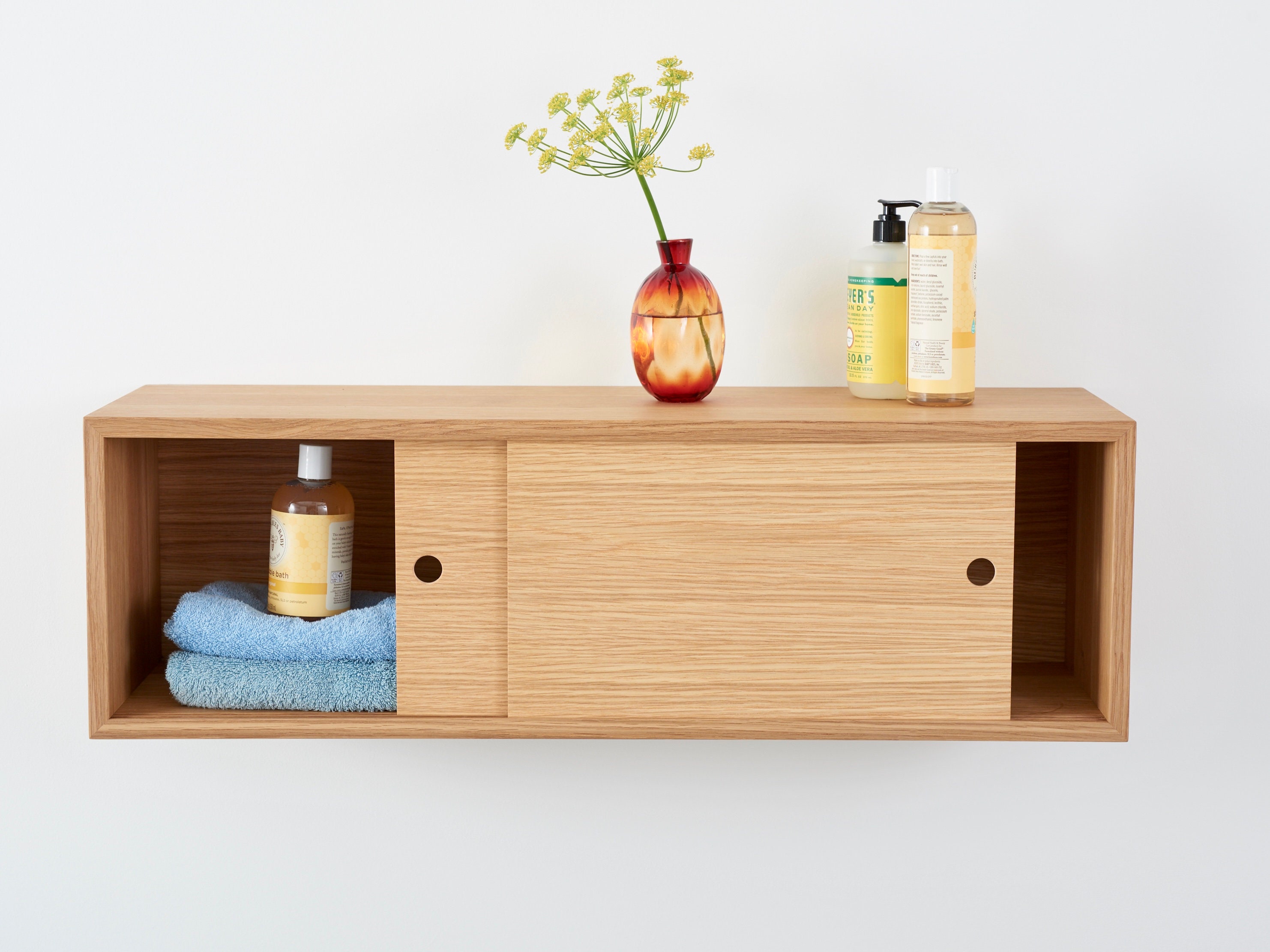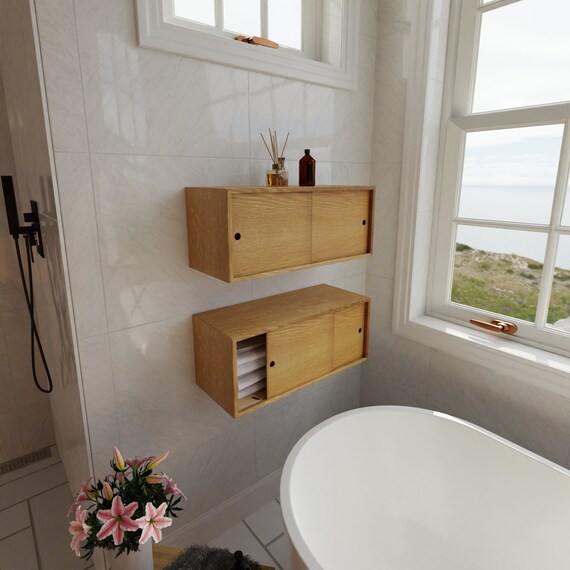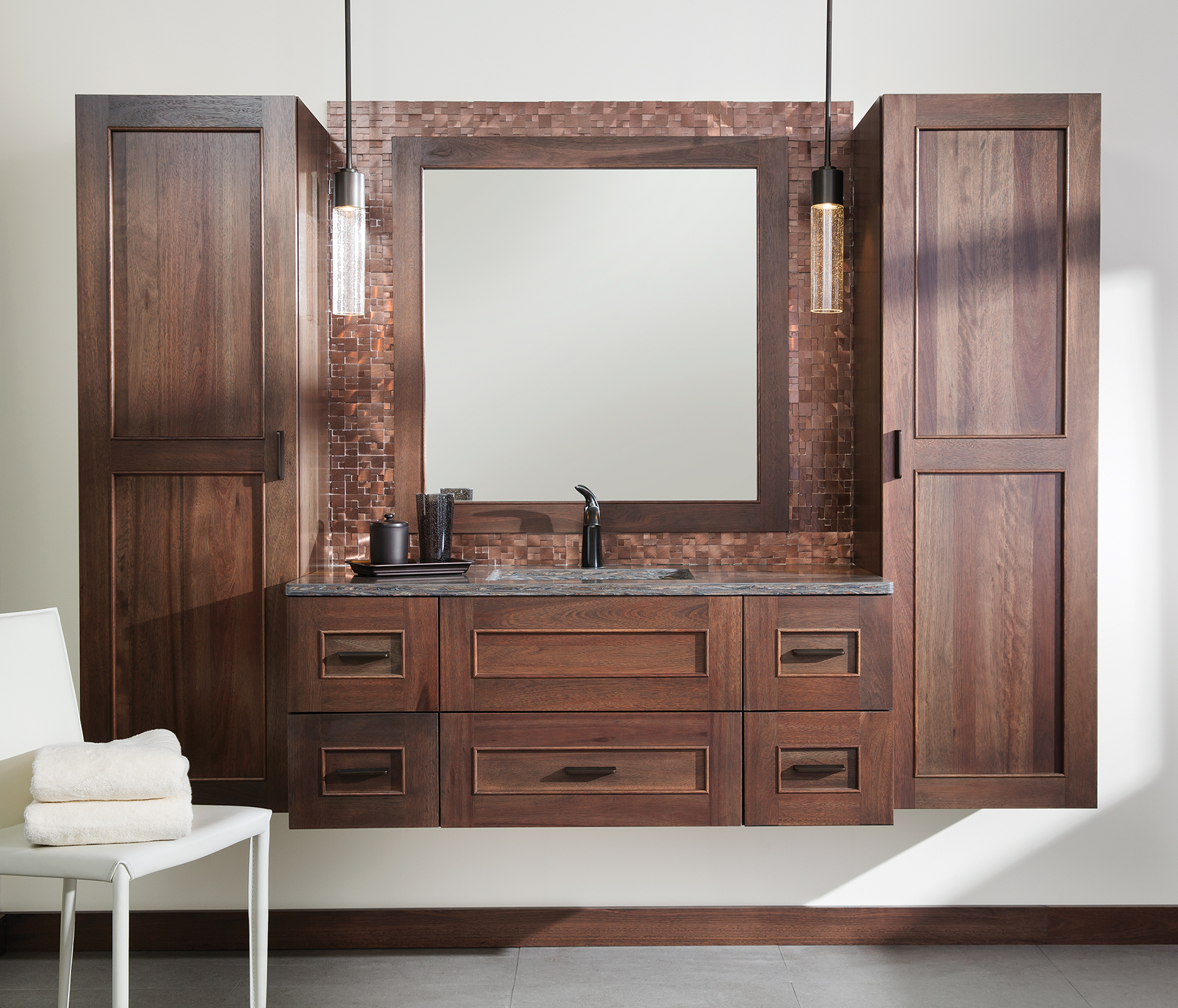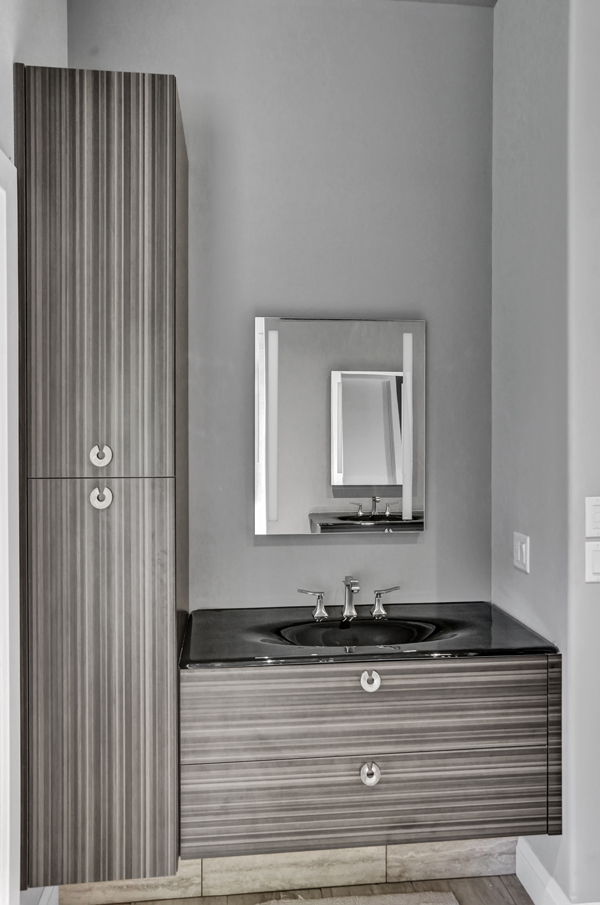Benefits of Choosing Floating Storage Cabinets
Floating storage cabinets have gained popularity for their sleek design and practical benefits. Unlike traditional cabinets that rest on the floor, floating cabinets are mounted on the wall, creating a modern and airy feel in the bathroom. Let’s explore the various advantages of opting for floating storage cabinets in your bathroom.
- Enhanced Space Utilization: One of the primary benefits of floating storage cabinets is the efficient use of space. By being mounted on the wall, they free up floor space, making even small bathrooms feel larger and more open. This design is particularly beneficial in compact bathrooms where every square inch counts.
- Easy Cleaning and Maintenance: Cleaning becomes a breeze with floating cabinets. With no base touching the floor, there’s no need to worry about dust and grime accumulating at the bottom. This design makes it easier to sweep and mop the bathroom floor, ensuring a cleaner and more hygienic space.
- Modern Aesthetic Appeal: Floating storage cabinets offer a sleek and contemporary look that can enhance the overall aesthetics of your bathroom. Their minimalist design can make the space appear more elegant and organized. Whether you prefer a modern or transitional style, floating cabinets can complement various bathroom décors.
- Versatile Design Options: These cabinets come in a variety of styles, materials, and finishes, providing ample options to match your bathroom’s design theme. From rustic wooden finishes to glossy modern looks, there’s a floating cabinet to suit every taste. This versatility makes them a popular choice among homeowners and interior designers alike.
- Increased Storage Options: Despite their minimalist appearance, floating cabinets can offer ample storage space. Many designs feature multiple shelves and compartments, allowing you to store toiletries, towels, and other bathroom essentials neatly. This organization can help keep your bathroom clutter-free and more functional.
- Improved Accessibility: Floating cabinets can be installed at any height, making them more accessible for everyone in the household. This customization is particularly useful for accommodating the needs of children, elderly family members, or individuals with mobility issues. It allows for easier access to stored items, enhancing convenience and usability.

Materials and Styles for Floating Cabinets
Choosing the right materials and styles for floating bathroom cabinets is crucial for both functionality and aesthetics. The options are vast, ranging from traditional wood to modern acrylics, ensuring there’s something to suit every taste and need. Let’s talk about the various materials and styles available for floating cabinets.
- Wooden Floating Cabinets: Wood is a timeless choice that adds warmth and character to any bathroom. Oak, maple, and walnut are popular options, each offering unique grain patterns and tones. Wooden cabinets can be finished with a natural stain or painted in various colors to match your bathroom décor. They are durable and can be treated to withstand moisture, making them suitable for bathroom environments.
- Laminate and MDF Cabinets: Laminate and medium-density fiberboard (MDF) are cost-effective alternatives to solid wood. These materials can mimic the appearance of wood and come in a wide range of colors and finishes. Laminate cabinets are easy to clean and resistant to moisture, making them a practical choice for busy bathrooms. MDF cabinets offer a smooth finish and can be painted to match your desired color scheme.
- Glass and Acrylic Cabinets: For a modern and sleek look, glass and acrylic floating cabinets are excellent choices. Glass cabinets can be clear, frosted, or tinted, adding a touch of elegance to the bathroom. Acrylic cabinets, on the other hand, are lightweight, durable, and available in various vibrant colors. Both materials are easy to clean and maintain, making them ideal for contemporary bathroom designs.
- Metal Cabinets: Metal floating cabinets, typically made from stainless steel or aluminum, offer a modern and industrial look. These cabinets are extremely durable and resistant to rust and corrosion, making them ideal for high-moisture areas. Metal cabinets can be polished for a shiny finish or brushed for a matte look, adding a unique touch to your bathroom décor.
- Combination Cabinets: Combining different materials can create a unique and personalized look for your floating cabinets. For instance, a wooden cabinet with glass doors or metal handles can offer a blend of traditional and modern styles. These combinations allow you to customize your cabinets to perfectly match your bathroom’s design theme.
- Custom and DIY Options: If you have specific requirements or a unique vision for your bathroom, custom-made floating cabinets might be the way to go. Custom cabinets can be designed to fit your exact dimensions and style preferences, ensuring a perfect fit and look. Additionally, DIY enthusiasts can build their own floating cabinets using a variety of materials, allowing for complete creative freedom and cost savings.
Installation Tips for Floating Bathroom Cabinets
Installing floating bathroom cabinets requires careful planning and precision to ensure they are securely mounted and aesthetically pleasing. Whether you’re a DIY enthusiast or hiring a professional, these installation tips will help you achieve a flawless result.
- Choose the Right Location: The first step in installing floating cabinets is selecting the appropriate location. Consider the layout of your bathroom and the placement of plumbing fixtures. Ensure the cabinets will not obstruct access to essential items or create an imbalance in the room’s design. It’s also important to avoid areas with excessive moisture, such as directly above a shower.
- Measure and Mark: Accurate measurements are crucial for a successful installation. Use a level and measuring tape to mark the desired height and width of the cabinets on the wall. Ensure the markings are even and level to avoid a crooked installation. Double-check your measurements to prevent any mistakes that could compromise the stability and appearance of the cabinets.
- Find the Studs: Floating cabinets need to be securely anchored to the wall, which requires finding the wall studs. Use a stud finder to locate the studs in the wall and mark their positions. If the studs do not align with the cabinet’s mounting points, use a mounting bracket or a piece of plywood as a support structure to distribute the weight evenly.
- Use the Right Hardware: The hardware used for mounting floating cabinets is critical for their stability and safety. Heavy-duty wall anchors or toggle bolts are recommended for securing the cabinets to the studs. Make sure to use screws and brackets that are appropriate for the cabinet’s weight and the type of wall material. This will ensure the cabinets remain securely in place.
- Secure the Cabinets: Once you have marked the stud locations and prepared the hardware, it’s time to mount the cabinets. Align the cabinet with the marked positions on the wall and secure it using the appropriate screws and anchors. Use a level to ensure the cabinet is straight before fully tightening the screws. It’s often helpful to have an extra pair of hands to hold the cabinet in place while you secure it.
- Finishing Touches: After the cabinets are securely mounted, add any finishing touches to complete the installation. This may include attaching doors, handles, and shelves. Ensure all components are properly aligned and functioning smoothly. Finally, clean the cabinets and surrounding area to remove any dust or debris from the installation process.
Creative Storage Solutions with Floating Cabinets
Floating cabinets are not just functional; they can also be a stylish and creative solution for maximizing storage in your bathroom. By thinking outside the box, you can make the most of these versatile pieces to keep your bathroom organized and clutter-free. Here are some innovative storage solutions using floating cabinets.
- Tiered Storage Systems: Create a tiered storage system by installing multiple floating cabinets at different heights. This design not only adds visual interest but also provides additional storage space for various items. Use the lower cabinets for everyday essentials and the higher ones for less frequently used items, keeping everything within easy reach.
- Integrated Lighting: Enhance the functionality and aesthetics of your floating cabinets by integrating lighting. LED strips or puck lights installed underneath the cabinets can provide additional illumination for your bathroom. This feature is particularly useful for adding ambiance and making it easier to find items stored in the cabinets.
- Combination of Open and Closed Storage: Mix open shelves with closed cabinets to create a balanced and practical storage solution. Open shelves are perfect for displaying decorative items, plants, or neatly folded towels, while closed cabinets can hide away less attractive necessities. This combination allows you to maintain an organized and visually appealing bathroom.
- Utilize Corners and Unused Spaces: Floating cabinets can be installed in corners or other unused spaces to maximize storage potential. Corner cabinets are especially useful for making use of awkward spaces that are often overlooked. By customizing the size and shape of the cabinets, you can create storage solutions that fit perfectly into any nook or cranny in your bathroom.
- Multi-Functional Cabinets: Consider installing floating cabinets with built-in features, such as mirrors, towel racks, or laundry hampers. These multi-functional cabinets can save space and add convenience to your bathroom routine. For example, a floating cabinet with a mirrored door can serve as both a storage solution and a vanity, streamlining your morning routine.
- Color Coordination and Decorative Elements: Use color and decorative elements to enhance the overall look of your floating cabinets. Choose cabinet finishes that complement your bathroom’s color scheme and décor. Adding decorative hardware, such as stylish handles or knobs, can also elevate the design. Additionally, consider incorporating patterned wallpaper or backsplashes behind the cabinets to create a unique and personalized look.
Maintenance and Care for Floating Cabinets
Proper maintenance and care are essential for keeping your floating bathroom cabinets in top condition. Regular cleaning and upkeep will not only prolong their lifespan but also ensure they remain an attractive feature in your bathroom. Here are some tips for maintaining and caring for floating cabinets.
- Regular Cleaning: Dust and dirt can accumulate on the surfaces of floating cabinets, affecting their appearance and hygiene. Wipe down the cabinets regularly with a soft, damp cloth to remove dust and debris. For stubborn stains or grime, use a mild detergent or a specialized cleaner suitable for the cabinet material. Avoid using abrasive cleaners or rough scrubbing pads that could damage the finish.
- Protect Against Moisture: Bathrooms are prone to high humidity and moisture, which can cause damage to floating cabinets over time. To protect your cabinets, ensure they are sealed properly and that there is adequate ventilation in the bathroom. Use a dehumidifier or exhaust fan to reduce moisture levels. Additionally, wipe down the cabinets if they become wet to prevent water damage and mold growth.
- Check for Damage: Regularly inspect your floating cabinets for any signs of damage, such as loose screws, cracked panels, or peeling finishes. Address any issues promptly to prevent further damage and ensure the cabinets remain securely mounted. Tighten loose screws, apply touch-up paint to chipped areas, and replace damaged components as needed.
- Maintain the Hardware: The hardware used to mount and operate your floating cabinets, such as hinges and handles, should also be maintained. Lubricate hinges and slides periodically to ensure smooth operation and prevent squeaking. If the hardware becomes damaged or worn, replace it with new, high-quality pieces to maintain the functionality and appearance of the cabinets.
- Avoid Overloading: While floating cabinets are designed to hold various items, overloading them can cause stress on the mounting hardware and the cabinet structure. Distribute the weight evenly and avoid placing excessively heavy items in the cabinets. Follow the manufacturer’s weight recommendations to prevent damage and ensure the cabinets remain securely mounted.
- Refinishing and Upgrading: Over time, the finish on your floating cabinets may start to wear or look outdated. Consider refinishing the cabinets to restore their original appearance or give them a new look. Sand down the surfaces, apply a fresh coat of paint or stain and seal them properly to protect against moisture. Upgrading the hardware, such as handles and knobs, can also give your cabinets a fresh and updated look.
Common Mistakes to Avoid When Installing Floating Bathroom Cabinets
Installing floating bathroom cabinets can be a rewarding DIY project, but it’s important to avoid common mistakes that can compromise the final result. By being aware of these pitfalls, you can ensure a successful and safe installation. Here are some common mistakes to avoid.
Incorrect Measurements: One of the most critical steps in installing floating cabinets is taking accurate measurements. Incorrect measurements can lead to cabinets that don’t fit properly or are unevenly mounted. Double-check all measurements before drilling any holes or securing the cabinets to the wall. Use a level and measuring tape to ensure precision.
Ignoring Wall Studs: Floating cabinets need to be securely anchored to wall studs to support their weight. Failing to locate and use wall studs can result in cabinets that are not properly secured and may eventually fall. Use a stud finder to locate the studs and ensure that the mounting hardware is anchored into them. If studs are not available in the desired location, use appropriate wall anchors or mounting brackets.
Using Inadequate Hardware: The hardware used for mounting floating cabinets is crucial for their stability and safety. Using inadequate or incorrect hardware can lead to cabinets that are not securely attached to the wall. Choose heavy-duty screws, anchors, and brackets that are appropriate for the cabinet’s weight and the type of wall material. Follow the manufacturer’s recommendations for the best results.
Poor Placement: The placement of floating cabinets is important for both functionality and aesthetics. Placing cabinets too high or too low can make them difficult to use and create an unbalanced look. Consider the height and reach of all users in the household when determining the placement. Ensure the cabinets are positioned in a way that enhances the overall design and usability of the bathroom.
Overlooking Leveling: Ensuring that floating cabinets are level is crucial for both their appearance and functionality. Cabinets that are not level can cause doors to swing open or closed and items to shift inside. Use a level during installation to ensure the cabinets are perfectly horizontal. Adjust as needed before fully securing the cabinets to the wall.
Skipping the Finishing Touches: After the cabinets are installed, it’s important not to overlook the finishing touches. This includes attaching doors, handles, and shelves, as well as cleaning up any dust or debris from the installation process. Neglecting these final steps can leave your cabinets looking incomplete and unpolished. Take the time to ensure all components are properly aligned and functioning smoothly.
Wayfair Wall Mounted Bathroom Cabinets
Evanna 48″ Single Sink Floating Vanity with Doors
36″ Floating Bathroom Vanity with Single Sink Wall Mounted Cabinet
VINGLI Bathroom Medicine Cabinet 2 Door Wall Mounted Storage Cabinet Over Toilet Cabinet Bathroom Kitchen Office Floating Storage Collection Orgaznier
Evanna 24-40″ Single Sink Floating Vanity
WONLINE 24″ Wall Mounted Bathroom Vanity Set Two
Floating Bathroom Storage Cabinet With Sliding Doors Vanity – Etsy
Related Posts:
- Bathroom Storage Furniture Sets
- Industrial Bathroom Storage
- Freestanding Under Sink Bathroom Storage
- Bathroom Storage Mirror Ideas
- How to Build Bathroom Storage
- Bathroom Storage No Medicine Cabinet
- Bathroom Storage Ideas for Towels
- Bathroom Storage Stand Alone Cabinet
- Bathroom Storage Cabinets Wall Mount India
- Bathroom Storage Cabinet Very







/fit-in/600x600/mall/file/2021/10/29/57592dc796cc4b1cb2e3e4274143732e.jpg)



